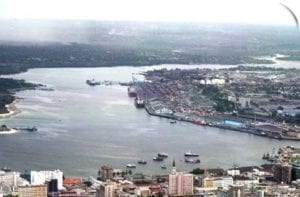The Dar es Salaam Port is a strategic entry and exit point for two major transit corridors in central east and southern Africa’s land-locked countries.
The port serves the central corridor running from Rwanda, Burundi, Uganda and Democratic Republic of Congo (DRC) that share its borders with Tanzania. The other is the southwest corridor running through Tanzania to Zambia and Malawi. It is also strategically placed to serve as a convenient freight linkage to the Middle East, Far East, Europe, Australia and the Americas. Despite Dar Port’s comparative advantages to its nearest rivals in the region, the port has bidding constraints, the major one being congestion where cargos dwelling time stands at nine days. To overcome the said obstacle, Tanzania joined hands with the US, and last week opened One Stop Centre (OSC) at Dar es Salaam port, which was long waited and industrial players have described it as a good leap forward. The OSC is the government initiative as one approach to improve the country’s doing business raking and competitiveness. Tanzania is ranked 127 on the World Bank’s Doing Business 2012 report. The OSC that housed eleven government agencies and institutions, which in one or another integrated in clearing and forwarding various goods at the port, designed to cut down port dwelling and documentation time to five days from nine. The Minister for Investment and Empowerment, Dr Mary Nagu, said though the centre is operating manually it is still the greatest milestone on easing bidding constraints on doing business in the country. “I wish to underscore the rationale of one stop centre in our efforts to transform Tanzania into a regional logistic hub,” Dr Nagu said, “with the view to stimulating regional trade.” Dar port handles about 95 per cent of the Tanzania international trade, serving six neighbouring land-locked countries in SADC and EAC blocs. “Effective operationalisation of the one stop centre…will greatly improve Tanzania’s score in the Trading Across Border Index,” Dr Nagu, who is an economist, said. She added the OCS is currently a manual single window operation opted to rescue the situation as an immediate and temporary solution towards reaching the electronic operation. The minister said the Dar port OSC has paved the way for the opening of similar centres at all ports in the country and key border posts to facilitate trade within the region. The Tanzania Port Authority (TPA) Director General, Ephraim Mgawe, said the OSC is currently located at temporary building but will be shifted to its permanent base in a 35-storey building that is under construction adjacent to TRA’s long room. “The contractor is already at the site,” Mr Mgawe said adding “the construction of the tallest building in the city is expected to take three years at the cost of 100bn/-.” The TPA DG said to establish the one stop centre, depending on the volume of business it handles, costs not less than 150m/-.The centre, according to the US Agency for International Development (USAID) Tanzania Mission Director Robert Cunnane, would cut short the travel time for clearing and forwarding agents to zero from current estimated 14 kilometres used to complete one clearance.
“Éthe layout of the One Stop Centre…will allow Dar es Salam to become a truly modern port…we (US) believe that Tanzania has bright future as a leading exporter in East Africa,” Mr Cunnane said. USAID partnered with TPA on designing of the centre and it contributed 50,000 US dollars for the information technology system, through its USAID/COMPETES — the Competitiveness and Trade Expansion Programme. Chairman of the Container Freight Station ICDs Dry port Association of Tanzania (CIDAT) Mr Ashraf Khan said OSC would further improve supply chain at the port by increasing efficiency in clearing process. “This was supposed to come long time ago, like yesterday. But we are happy at long last it’s operational,” Mr Khan said. The Chairman told the ‘Daily News’ that CIDAT had proposed the formation of the centre during their Dar es Salaam Port Improving Committee as way of reducing congestion. He said even the dwell time reduction to nine days from 17 days of 2009 was the result of the Inland Container Depot (ICD) to support the port cargo movements. “It is possible to reduce the dwelling time to hours,” Mr Khan, also a General Manager of Azam Inland Container Depot, said. The benefits of the OSC are many but among them are efficiency in processing cargo clearance of documents by reducing number of procedures, reducing physical movement, minimising bureaucracy, hence transparency, joint verification of cargo and harmonising of working hours. The OSC will enhance Trading Across Border Index, which measures the time and cost spent by businesses in cargo clearance at the Port and Border Posts. The centre will compliment the 24 hours operation of the Port of Dar and the ongoing exercise of reducing the permanent roadblocks across the highways — with the objective of putting all cargo and vehicle inspectors at weighbridge. Source: http://allafrica.com







